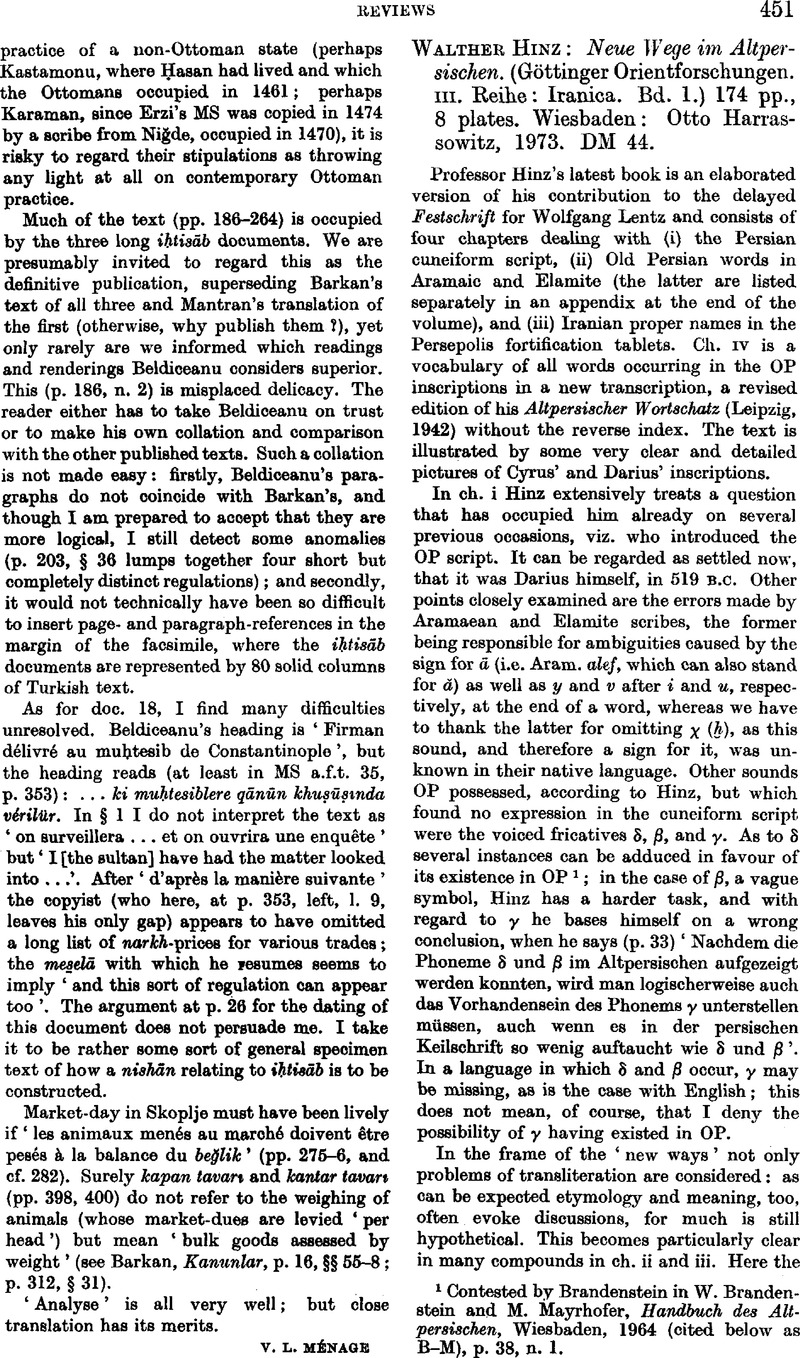No CrossRef data available.
Article contents
Walther Hinz: Neue Wege im Altpersischen. (Göttinger Orientforschungen. III. in. Reihe: Iranica. Bd. 1.) 174 pp., 8 plates. Wiesbaden: Otto Harrassowitz, 1973. DM 44.
Published online by Cambridge University Press: 24 December 2009
Abstract

- Type
- Reviews
- Information
- Copyright
- Copyright © School of Oriental and African Studies 1975
References
1 Contested by Brandenstein in Brandenstein, W. and Mayrhofer, M., Handbuch des Altpersischen, Wiesbaden, 1964 (cited below as B-M), p. 38, n. 1.Google Scholar
2 ‘Nachlese zur achaimenidischen Anthroponomastik’, Beiträge zur Namenforschung, NF, vi, 1, 1971, lift., esp. 14.Google Scholar
3 Gershevitch, I., ‘Amber at Persepolis’, Studia A. Pagliaro, ii, Roma, 1969, 201: *ka-lauka- ‘what an offspring’, formed like Av. κaχvareδa-, but perhaps as an expression of admiration rather than exasperation […]. Of course *κāt***-υahu-ka- ‘of good honour’ […] is also possible. Bartholomae, Altir. Wb., col. 462, explains κaχυare δa by ‘Bezeichnung einer Klasse von (männlichen und weiblichen) Wesen der daëvischen Schöpfung. Ableitung—Eigentlich vielleicht “was für ein (abscheulicher) schwarzer (Kerl)”’ and compares Italian negraccio.Google Scholar
4 Hinz, 114: ‘wie lieb!’
5 M. Mayrhofer, review of Kent's, R. G.Old Persian, second ed., IIJ, I, 2, 1957, 178.Google Scholar
6 Gershevitch, ‘Amber’, 224, s.v. Pid(d)abarma.
7 ‘Zur Inschrift von Behistān I 63’, ZDMG, Liii, 1899, 89–92; review of Bartholomae, Altiranisches Wörterbitch, in: IF Anz., XVII, 1904–5, 111.
8 Foy, W., ‘Beiträge zur Erklärung der susischen Achaemenideninschriften’, ZDMG, LII, 1898. p. 599, n. 1. Justi in his review of Bartholomae had already rejected this rendering, because cows have no brows—an argument against which Foy replied that proper names need not carry a sense, if they consist of members of two compounded names that had a meaning and occurred already in the family (‘Altpersisch und Neuelamisch’, ZDMG, Liv, 1900, 360). Boisacq in his Dictionnaire étymologique de la langue grècque, fourth ed., Heidelberg, 1950, 733, took sides with Foy, though we have not met with other OP names containing -brūva (thus Boisacq) ~ ⋯φρ***ς, nor, for that matter, Greek ones. In canonical Pali, however, in the description of the body signs of a Mahāpurisa the words gopakhuma ‘having eyelashes like a heifer’ (Rhys Davids at Dīghanikaya, II, 18, 28; cf. iii, 144, 24) and its apparent equivalent ***lārapamha ‘with curved eyelashes’ (CPD; Ja,, v, 215, 8*; Vv., 752, perhaps also Ja., VI, 503, 15*; see also the Pali-English dictionary s.v. bhamuka and cf. Sanskrit arālapaksman) are found.Google Scholar
9 The extension in the Greek word continues, as we now know from the Mycenaean documents (vide Chadwick and Baumbach, ‘The Mycenaean Greek vocabulary’, Glotta, XLI, 1963, 253), an IE labiovelar, and not -gh as assumed formerly, though it does not make a difference in the end.
10 A concise etymological Sanskrit dictionary, s.v. bhárvati.
11 Thus Chadwick, J., Documents in Mycenaean Greek, second ed., Cambridge, 1973, 548.Google Scholar
12 Geldner translated súbharva in the first passage by ‘gut kauend’ (‘chewing well’), in the second by ‘wohlgenahrt’ (‘well nourished’).
13 Walde-Pokorny, , Vergleichendea Wōrterbuch der indogermanischen Sprachen, ii, Berlin, 1927, 164 f.. had assumed various extensions of 8√bher ‘essen, verzehren’, which H. Frisk, Griechisches etymologisches Wōrterbuch, Heidelberg, 1970, s.v. φ⋯ρβω, regards as improbable. In Pokorny's Indogermanisches etymologisehes Wōrterbuch, Bern, 1959, φ⋯ρβω is no longer mentioned at all, whereas bhárvati is placed under 3√bher ‘mit einem scharfen Werkzeug bearbeiten, ritzen, schneiden, reiben, spalten’ (p. 133). p. 150: rtaχšaça: Ἀρταξ⋯ρξης, according to Hinz, means ‘etwa: “Reich der rechten Ordnung”’. Probably lapsus for ‘ein Reich…habend’, cf. Kent (op. cit., 171), ‘Having a kingdom of justice’. Otherwise Mayrhofer (B-M, 106, Arlaḫšaça-): ‘Der das arta- zur.Google Scholar
14 See Altheim, F. and Stiehl, R., Geschichte Mittelasiens im Altertum, Berlin, 1970, bk. i, ch. iii, esp. pp. 58–61.CrossRefGoogle Scholar
15 Bailey, H. W., ‘Ancient Kamboja’, in Bosworth, C. E. (ed.), Iran and Islam: in memory of V. Minorsky, Edinburgh, 1971, 66–71.Google Scholar See also my forthcoming Studien zum Sūyagada. note on 2, 1, 13, and my review of Norman's, K. R.The elders’ verses, JAOS, xciii, 4, 1973, 602.Google Scholar
16 cf. Frye, R., The heritage of Persia, second ed., London, 1965, 97.Google Scholar
17 ‘läuft’ (Hinz).
18 Altiranisches Wörterbuch, Strassburg, 1904, col. 390, ‘etwa: “der Ordnung untertan”’
19 Herzfeld, E., Altpersische Inschriflen, Berlin, 1938, 190, assumes a nasalized root *dhere-n-gh-, an extended form of IE √dher.Google Scholar
20 The ṚV simplex dhàrman had already become dhàrma in the AV.
21 See Hopkins, E. W., Epic mythology, Strassburg, 1915, 133Google Scholar and 204, respectively. Hilka, A., Die altindischen Personennamen, Breslau, 1910, 76, mentions instances from the Visiiupurāna and the Jātakas.Google Scholar
22 Malalasekera, G. P., Dictionary of Pāli proper names, London, 1937, 402.Google Scholar
23 See Renou, L., Grammaire sanscrite, second ed., Paris, 1968, 96.Google Scholar
24 Also Tigrakā and Upatigra (Hinz, 116) ?
25 Upadharma is transmitted as the name of one of Śāriputra's brothers (Edgerton, BHSD).
26 Schwyzer, E., Griechische Grammatik, I, München, 1939, 634, 637.Google Scholar
27 Gershevitch, ‘Amber’, 172.
28 Gershevitch, ‘Amber’, 199, connected it with Modern Persian kahra ‘kid’. Cf. above under činčaχri.
29 According to Gershevitch, ‘Iranian nouns and names in Elamite garb’, TPS, 1969, 196, an i-patronymic of *taχma-turu- ‘having valiant coursers’.
30 Gershevitch,‘Amber’, 236.


